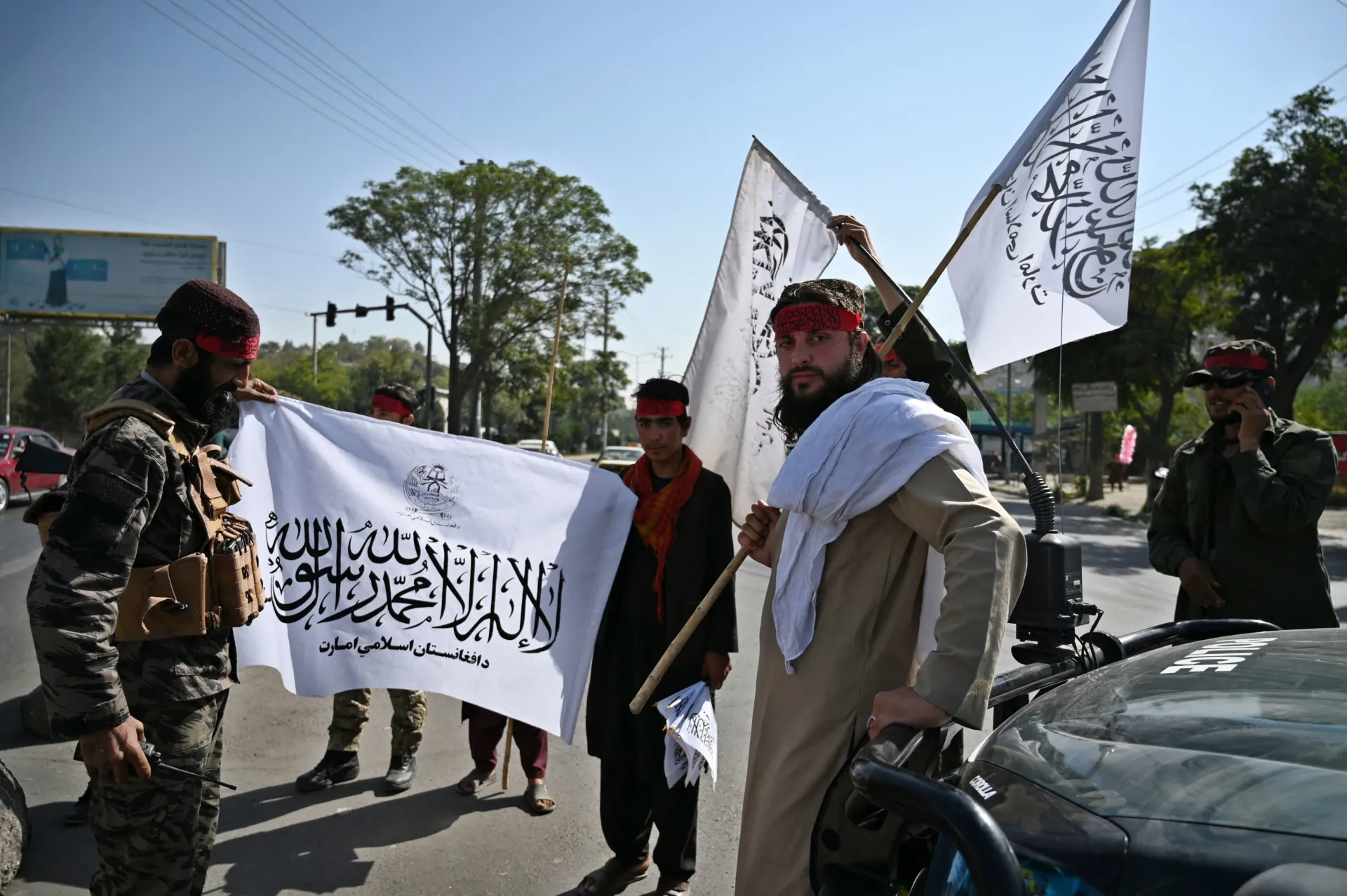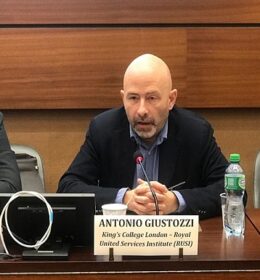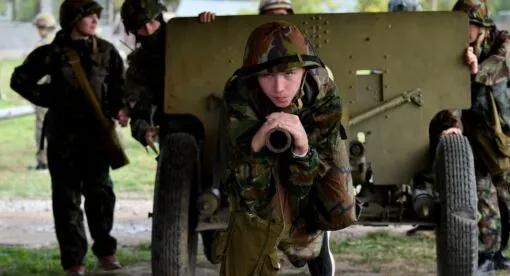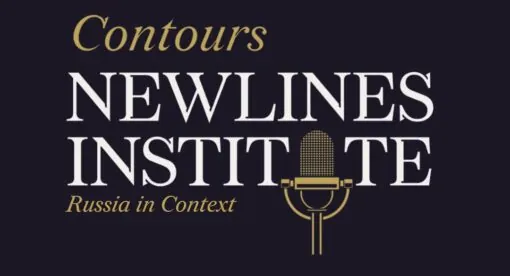The Taliban’s rapid takeover of Afghanistan after the withdrawal of U.S. forces was aided by a network of local and international relationships that the group had been cultivating for years.
Much of the analysis of Afghanistan and the Taliban has shared the assumption that the main actors in and around Afghanistan believe the Taliban are an isolated jihadist movement, with no friends other than fellow jihadists. This analysis assumed that except for Pakistan, the surrounding countries would all be terrorized by the prospect of the Taliban rising to power and that, for that reason, there would be an interest in keeping the United States in Afghanistan. It was also assumed that any dealings with the Taliban would be anathema for stakeholders in the now-defunct Islamic Republic of Afghanistan and that, faced with the Taliban threat, the bickering factions in Kabul would unite to resist them.
The reality is much more complex and often very far from these assumptions. Even today, despite growing evidence that the Taliban were not isolated at all as they marched on Kabul, there remains a tendency to underestimate the level of support that the Taliban have been receiving, both from within Afghanistan and outside it.
Business Partners
Inside Afghanistan, the Taliban have been building relations with other groups for years, initially around shared economic interests. In Badakhshan and in the northeast, for example, the Taliban and local commanders of Jami’at-i Islami have been jointly taxing mining operations and smuggling. Relations were established with the militias of Haji Zahir Qadir in Nangarhar and some smugglers linked to Jami’at in Parwan. In the south, drug traders dealt with both Taliban and Afghan security forces and state officials, often getting Taliban and state actors to cooperate with each other in facilitating smuggling operations, for example by letting drug caravans through. In Nimroz, state officials and Taliban would tax and extort truckers and smugglers just hundreds of meters from each other.
Countrywide, the picture was one of extensive dealmaking. In the police forces, working out arrangements with the Taliban such as cease-fires was also quite common. While these agreements were local and tactical, they established a habit of coexistence and collaboration that would turn out to be useful for the Taliban as a whole.
Warming Up Against a Common Enemy
Gradually, these relations deepened, especially following three presidential elections where the Jami’at-i Islami candidate, Abdullah Abdullah, lost amid allegations of widespread voter fraud. With the prospect of Jami’at getting to power in Kabul looking slim, its leaders started warming to the idea of cooperation with the Taliban. By 2018, Jami’at leaders were openly telling Western diplomats that the Taliban might in several ways be preferable to Ghani.
The Jamia’tis were not alone in their frustration. When Gulbuddin Hekmatyar’s Hizb-e Islami signed a peace deal in 2016, the Taliban were upset and started targeting its members in various parts of the country. But the honeymoon between Hekmatyar and Ghani did not last long, and soon the two were at loggerheads. By 2018, Hekmatyar was edging closer to the Taliban, and a full friendship blossomed months before Ghani’s regime unraveled.
Other groups in 2001’s Bonn Agreement (when anti-Taliban factions agreed on the establishment of the Islamic Republic) that were completely marginalized by 2020-2021 included Mahaz-e Milli, a Sufi party that started establishing a cozy relationship with the Taliban, and Hazara groups such as the faction of Hizb-e Wahdat loyal to former Vice President Karim Khalili, which reached an understanding with the Taliban in spring 2021 despite the history of friction between Taliban and Shiites in the 1990s.
These relationships would turn into actual agreements that played a key role in the collapse of the Islamic Republic in mid-2021.

Collusion Against Ghani
The faction of Salahuddin Rabbani in Jami’at was the first to make a deal with the Taliban in June 2021. Rabbani’s followers, many of whom were already involved in economic dealings with the Taliban, opted out of the conflict, especially in northeastern Afghanistan. Their defection was started by the clash between Ghani and Gen. Abdul Rashid Dostum in the northwest, which convinced them that Ghani wanted to eradicate the northern powerbrokers. These actions kickstarted the collapse of the republic nationwide.
In late June and early July, Jami’at commanders more loosely aligned with Rabbani started making deals in western Afghanistan as well. At that point, Hazara militia commanders linked to Khalili and police officers and militia commanders loyal to former president Hamid Karzai and to other southern notables also sealed deals with the Taliban, helping them easily take most of the south.

The Regional Dimension
The Taliban’s blossoming relationship with so many key actors within the political landscape of the Islamic Republic was facilitated by regional powers such as Russia, Iran, and Pakistan, which had already started their process of rapprochement with the group. Saudi Arabia also provided significant support, and China provided support through Pakistan on and off for quite some time. The Taliban also received smaller levels of support from Qatar and Kuwait.
Originally, support for the Taliban by regional powers was driven by concerns about a long-term U.S. presence. For Iran, China, and Pakistan, although with not entirely coinciding perspectives, the apparent determination of the U.S. to stay put in Afghanistan with permanent military bases was a provocation, a hostile force entering their immediate neighborhood.

These powers thus came to see the Taliban as the only effective vehicle for preventing U.S. consolidation in Afghanistan. The Pakistanis resumed substantive support for the Taliban in 2004 in the hope of using them as a tool of pressure on Kabul and on Washington, which could remind the latter that it had committed to protect Islamabad’s interests in Afghanistan. Pakistani influence in Afghanistan was still at its nadir, and many in Pakistan’s military were becoming restless.
The Iranians followed with a major shift in their policy toward the Taliban in 2005, first with very modest support for the group, which was then increased year on year after the Taliban were found to be useful partners – at one point possibly exceeding Pakistan’s level of support. The Iranians did experience problems in their relationship, however: In 2014, they feared the Taliban were about to re-establish a close relationship with the Saudis, and in 2019-2020 they feared that the Taliban might become too cozy with the Americans by virtue of the U.S.-Taliban agreement. This would have represented a major failure for Iran, given the premises of its support to the Taliban. But the U.S. and Taliban were not able to sustain the momentum that seemed to be developing after the deal was signed, and today the prospects of close U.S.-Taliban relations are quite poor.
The Taliban as the Winning Horse
As the U.S. eventually started drawing down its forces from 2011 onward, some of these powers decided that their intervention in support of the Taliban was no longer warranted. That was the case of China, which started losing interest in the Taliban and developed concerns about their lingering connections with foreign jihadists, especially Central Asians and Uyghurs.
At the same time, as Afghan security forces started operating more on their own, Iran and Russia started losing faith in their ability to contain the Taliban without U.S. support. Once these regional powers accepted that the Americans were really on their way out, they considered extending support to the Afghan government but then decided that the Taliban were a more credible partner with real staying power. Their observation of the performance of the Afghan security forces as support from the U.S. and others was being drawn down convinced them that the Afghans would not be able to handle the Taliban.
They also realized that the level of corruption in the Islamic Republic was such that any investment in the security forces (with the aim of stabilizing Afghanistan) would mostly go to waste. The Iranians, who had been supporting the Taliban opportunistically in order to hurt the Americans, started seeing them as a longer-term asset. According to Taliban sources, the Iranians volunteered to introduce the Taliban to the Russians, who then proceeded to test the viability of the Taliban as a counter-insurgency tool against the Islamic State, which by 2016 was fast emerging as a major security concern for Moscow. The Russians were aware of the lingering connections between the Taliban, and especially some of their components, and al Qaeda and affiliated groups, but they saw al Qaeda as a force in decline and unable to mobilize the resources and the manpower to seriously threaten Russia’s interests. The Islamic State in Khorasan, with its growing appeal among Central Asian jihadists and (the Russians assessed) its rich funding, was identified as a priority target.

On this, Iranians and Russians converged. The Russians started supporting the Taliban with growing quantities of weaponry and with financial support. By 2021, Russia was the third-largest source of support to the Taliban, according to Taliban sources.
Separating the Taliban from Transnational Jihadism
Another rationale for supporting the Taliban, pioneered by the Saudis, was to drive a wedge between them and global jihadists. The Saudis initially appeared to also have been motivated by a desire to prevent the consolidation of an Afghan democracy in 2003-2004, but this aim lost importance in subsequent years as it became apparent that Afghanistan was unlikely to adopt democracy in the long term.
The Saudis also wanted to keep the Taliban away from Iran as much as possible and lobbied key Taliban figures to that end. At one point in 2014, they seemed to be on the verge of success, but the Iranians were able to stage a comeback in 2016 after Saudi-sponsored talks collapsed and Saudi influence suffered a serious blow.
More interestingly, the Saudis had also started developing an interest in separating the Taliban and al Qaeda and encouraging the Taliban to seek an accommodation with the U.S.-sponsored government in Kabul. It is not known whether they played a role in the first round of contacts between Taliban leaders such as Mullah Abdul Ghani Baradar and the Karzai administration in 2009-2010, which ended with Baradar’s detention in Pakistan. Taliban sources, however, reported for the first time a deterioration in relations between Taliban and al Qaeda affiliates in 2010, as the latter were becoming aware of the Taliban’s interest in talks. Al Qaeda’s response was to reorient its funding toward specific groups and individuals within the Taliban, which it deemed could be swayed away from talks with Kabul.
Other regional actors eventually came to the same conclusion: that the Taliban could not be defeated in the existing circumstances but could be separated from the global jihadists and perhaps driven toward agreements with other Afghan actors. This sense that the Taliban could be separated from the global jihadists owed much to the bitter fight that developed between the Taliban and the Islamic State from 2015 onward. Given that the Islamic State group was by far the largest global jihadist organization in Afghanistan at that point, with close to 10,000 members, turning the Taliban into a tool of a counterterrorism policy did not seem that far-fetched anymore.
Later in 2021, following Russia’s lead, even the Chinese authorities started considering the possibility of trading off support for the Taliban for their cooperation against Uyghur insurgents, some of whom were known to be in Afghanistan, mostly in the ranks of the Islamic State but also in the ranks of al Qaeda affiliates. Arguably, the Taliban’s fight with the Islamic State even facilitated the U.S. decision to pull out and to outline a post-withdrawal relationship with the Taliban in its agreement with the group in February 2020.
Managing Regime Transition
As the U.S.-Taliban peace agreement failed to produce sustained intra-Afghan peace talks, the regional powers (especially Pakistan, Iran, and Russia) moved in with their own plan of engineering relationships between the Taliban and old stakeholders of the Islamic Republic, such as Rabbani’s Jami’at, Karzai, and others. In this plan, the stakeholders would facilitate the Taliban ascent to power in exchange for guarantees of being incorporated into the emerging Taliban-led government. Russians, Iranians, and Pakistanis actively lobbied the old stakeholders, often in a coordinated way, and mediated between them and the Taliban, in most cases successfully.
The net outcome was expected to have a moderating impact on the Taliban, who would be imprisoned in the embrace of the old stakeholders and of the regional powers. A series of local deals was ideally supposed to culminate in a national-level agreement, ushering in an interim government that would replace the Ghani administration.
However, this interim government never took off, for several reasons, including sabotage efforts by Ghani; leading figures among the old stakeholders (Karzai and Abdullah, Ghani’s uneasy coalition ally) not wanting to risk the instability that would have come along with getting the interim government going with Ghani still in power in Kabul; and the Islamic Republic disintegrating too quickly for talks over an interim government to produce results.
Can the Taliban Cater to Their Partners’ Needs?
Over the years the Taliban have been successful in establishing partnerships with local and regional actors. Not all these partners were satisfied with the Taliban even before their power grab. The Saudis, for example, eventually stopped supporting the Taliban, and support from China and Iran has been intermittent.
As the Taliban took power in mid-August 2021, local partners who helped them march toward power were expecting to be incorporated in the new Taliban-led government. Ten days later, the Taliban were still negotiating power sharing with them but did not seem ready to concede them more than a 30% share of all senior government positions, which these partners deemed too low. As of the end August, no agreement had been reached, and the Taliban had abandoned negotiations with most of these partners.
Disappointment with the Taliban’s willingness and/or ability to deliver on their promises appeared to be growing at the regional level as well. Emboldened by their crushing victory, the Taliban seemed intent on declaring the re-establishment of the Emirate, not of a hybrid regime, which is what they had proposed to U.S. diplomats as the desired outcome of intra-Afghan talks. The regional powers had almost all hinted (or even stated strongly) that they did not wish to see a return of the Emirate and that they wished for a coalition government, even one led or dominated by the Taliban. With negotiations with the old stakeholders of the Islamic Republic faltering, the Taliban hardliners succeeded in imposing a Taliban-only Cabinet, as announced on Sept. 7.
Although the Taliban specified that it was a caretaker body only and that more appointments are forthcoming to complete the Cabinet, such an outcome disappointed the old stakeholders, who could then only hope to receive relatively minor appointments. Most of them are not likely to be interested, and indeed several of them already have left Afghanistan. The regional powers are disappointed too, to say the least, because many of those old stakeholders are their clients and allies, and talks about forming a coalition are now expected to last a long time and might end up being unsuccessful
Taliban hardliners are attempting to dictate terms both internally and externally, despite being dramatically short of funds to run the Afghan state machinery. As a member of the Taliban’s military commission put it in July, the belief was that at the end of the day, the regional powers will have to deal with the Taliban regime even if it does not fully meet their previous expectations. Similarly, many in the Taliban believed they do not need to share much power with powerbrokers and elite politicians, having the option of co-opting the lower layers of their power structure.
The prospect of the Taliban fighting an all-out war with the Islamic State while also facing the specter of economic collapse pushed the group toward talks, but internal divisions will make it difficult to reach a consensus over a coalition government.
Dr. Antonio Giustozzi is Senior Research Fellow in the Terrorism & Conflict program at the Royal United Services Institute (RUSI) in London. Dr. Giustozzi is the author of six books on the Afghan Taliban including “The Taliban at War” (Hurst, 2019). Guistozzi received his PhD at the London School of Economics, and is a frequent columnist on issues pertaining to Afghanistan. He tweets at @ AntonioGiustoz2.
The views expressed in this article are those of the author and not an official policy or position of the Newlines Institute.







